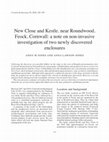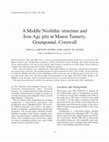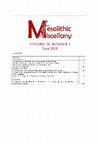Papers by Anna Lawson-Jones
Cornish Archaeology, 2020
Cornwall Archaeological Unit undertook a watching brief at Tyringham Road, Lelant, during groundw... more Cornwall Archaeological Unit undertook a watching brief at Tyringham Road, Lelant, during groundworks associated with a housing development. The most significant discovery was a pit associated with Beaker pottery and a worked stone assemblage. An initial date on charcoal from the pit produced an Early Neolithic radiocarbon determination, reflecting much earlier activity than the pottery. Interestingly, the pit was overlain by deposits of sandy soils which had preserved a quantity of animal bone. Animal bone rarely survives in Cornwall’s harsh acidic soils, so a few fragments were submitted for radiocarbon dating. These produced a later medieval date, with a range from the mid-fifteenth to early sixteenth century AD.

Cornish Archaeology 59, 2020
Following the discovery of a possible hillfort on the ridge to the west of Roundwood promontory f... more Following the discovery of a possible hillfort on the ridge to the west of Roundwood promontory fort, Cornwall Archaeological Unit undertook a programme of fieldwalking and geophysical survey across two fields named Kestle and New Close. Fieldwalking led to the identification of a concentration of artefacts in
New Close which included worked stone, flint and abraded unglazed pottery, some of which is of prehistoric and Roman-period date. Although Lidar appeared to confirm the presence of the large enclosure in Kestle field, the geophysical survey did not support this, leaving its identification unresolved. However, a second and previously unsuspected sub-rectangular enclosure was located in New Close.
This note presents a summary of results of the non-invasive surveys which have revealed new information about the use of a previously apparently blank area in the later prehistoric and Roman periods.

Cornish Archaeology, 2018
Archaeological fieldwork along a 5 km stretch of the A30 from Temple to Higher Carblake was carri... more Archaeological fieldwork along a 5 km stretch of the A30 from Temple to Higher Carblake was carried out by CAU between 2015 and 2017. Significant remains were found in two locations: towards the western end, 14 scattered pits, many of which had charcoal-rich fills; and to the east, a scatter of flints.
Only two of the pits produced any artefacts but eight had charcoal-rich fills suitable for analysis. Four radiocarbon determinations were secured which spanned the Mesolithic (c 7000 cal BC), the Early Neolithic (c 3800 cal BC) and the Middle Neolithic (c 3300 cal BC). These results are highly significant as they reveal a hitherto largely unknown Mesolithic and Neolithic presence on the fringes of the Moor. Soil stripping at Temple North, towards the eastern end of the scheme, led to the identification of an old land surface and a well-preserved scatter of lithics of Late Mesolithic to Early Neolithic date comprising over 268 flints and seven stone tools. This is significant as it reveals evidence for occupation in the heart of Bodmin Moor. Interestingly, the upland location of the flint scatter contrasts with the setting of the western pits, which are on lower ground off the granite moorland.

Archaeological Journal 170, 2013, 1-29, 2013
Between 2004 and 2011 nearly eight thousand prehistoric artefacts from ploughed fields across the... more Between 2004 and 2011 nearly eight thousand prehistoric artefacts from ploughed fields across the Clodgy Moor area of West Penwith. In 2011 a project was carried out by the Historic Environment Service Projects team, Cornwall Council, the Portable Antiquities Scheme and the Cornwall Archaeological Society to catalogue and digitize all the finds recorded from the fieldwalking.The project demonstrated that some places within the project area were persistent locales which were occupied throughout the Mesolithic and Neolithic periods. The results were particularly signifi cant because they shed light on the context of the production of greenstone axes, widely exchanged around Britain and across the Irish Sea during the Neolithic, and suggest why, despite large numbers of artefacts, no greenstone ‘axe factory’ site has been found close to the potential sources of the before.
http://www.tandfonline.com/doi/abs/10.1080/00665983.2013.11021000#.Va03tP_H_IU

Cornish Archaeology, 2016
Between October 2011 and May 2012 a series of archaeological watching briefs were carried out at ... more Between October 2011 and May 2012 a series of archaeological watching briefs were carried out at the Manor Tannery site, Grampound, in advance of the construction of new housing. One burnt spread and sixteen pits and postholes were uncovered, among other features, spread across three fields. None produced artefacts but eight had charcoal-rich fills suitable for analysis.
Three charcoal samples were s_ubmitted for radiocarbon dating, two from pits, and one from a posthole associated with a structure. The posthole produced a determination of 3634–3376 cal BC, placing it within the Middle Neolithic period. Buildings of this period are rare in Britain and it is the first to be recorded in the south-west region. The pits produced determinations in the range 380–100 cal BC, dating to the Middle to Late Iron Age, and are unusual because they are not associated with any artefacts. The following paper describes and considers the character of these features, and discusses their significance.

Mesolithic Miscellany, 2018
Between 1949 and 2015 Charles Thomas collected lithics from, and fieldwalked the Gwithian / North... more Between 1949 and 2015 Charles Thomas collected lithics from, and fieldwalked the Gwithian / North Cliffs area of west Cornwall, south-west England. Over this period he amassed many 1000s of Mesolithic flints and stone tools, mainly of greywacke, and identified more than 20 scatter sites in the area, which represents one of the densest concentrations in Cornwall. In 2016 Historic England funded the North Cliffs project, which involved the cataloguing and archiving of Mesolithic flints and stonework from four of the most significant
scatters, three of which were located in a large field close to the coast path with the fourth situated further inland. The cataloguing was undertaken by trained volunteers and a 20% sample of the flint and stone assemblages was then rapidly assessed by lithic specialists. The study revealed interesting contrasts between the flint scatters and evidence for the collection, working and circulation of Group XIX Greywacke. In light of the very significant results, it is suggested that fuller analyses of the North Cliffs assemblages has the potential to shed more light on the character of Mesolithic occupation at a regional level and also to contribute to national and perhaps European wide debates about contacts between communities and the circulation of artefacts.

Uploads
Papers by Anna Lawson-Jones
New Close which included worked stone, flint and abraded unglazed pottery, some of which is of prehistoric and Roman-period date. Although Lidar appeared to confirm the presence of the large enclosure in Kestle field, the geophysical survey did not support this, leaving its identification unresolved. However, a second and previously unsuspected sub-rectangular enclosure was located in New Close.
This note presents a summary of results of the non-invasive surveys which have revealed new information about the use of a previously apparently blank area in the later prehistoric and Roman periods.
Only two of the pits produced any artefacts but eight had charcoal-rich fills suitable for analysis. Four radiocarbon determinations were secured which spanned the Mesolithic (c 7000 cal BC), the Early Neolithic (c 3800 cal BC) and the Middle Neolithic (c 3300 cal BC). These results are highly significant as they reveal a hitherto largely unknown Mesolithic and Neolithic presence on the fringes of the Moor. Soil stripping at Temple North, towards the eastern end of the scheme, led to the identification of an old land surface and a well-preserved scatter of lithics of Late Mesolithic to Early Neolithic date comprising over 268 flints and seven stone tools. This is significant as it reveals evidence for occupation in the heart of Bodmin Moor. Interestingly, the upland location of the flint scatter contrasts with the setting of the western pits, which are on lower ground off the granite moorland.
http://www.tandfonline.com/doi/abs/10.1080/00665983.2013.11021000#.Va03tP_H_IU
Three charcoal samples were s_ubmitted for radiocarbon dating, two from pits, and one from a posthole associated with a structure. The posthole produced a determination of 3634–3376 cal BC, placing it within the Middle Neolithic period. Buildings of this period are rare in Britain and it is the first to be recorded in the south-west region. The pits produced determinations in the range 380–100 cal BC, dating to the Middle to Late Iron Age, and are unusual because they are not associated with any artefacts. The following paper describes and considers the character of these features, and discusses their significance.
scatters, three of which were located in a large field close to the coast path with the fourth situated further inland. The cataloguing was undertaken by trained volunteers and a 20% sample of the flint and stone assemblages was then rapidly assessed by lithic specialists. The study revealed interesting contrasts between the flint scatters and evidence for the collection, working and circulation of Group XIX Greywacke. In light of the very significant results, it is suggested that fuller analyses of the North Cliffs assemblages has the potential to shed more light on the character of Mesolithic occupation at a regional level and also to contribute to national and perhaps European wide debates about contacts between communities and the circulation of artefacts.
New Close which included worked stone, flint and abraded unglazed pottery, some of which is of prehistoric and Roman-period date. Although Lidar appeared to confirm the presence of the large enclosure in Kestle field, the geophysical survey did not support this, leaving its identification unresolved. However, a second and previously unsuspected sub-rectangular enclosure was located in New Close.
This note presents a summary of results of the non-invasive surveys which have revealed new information about the use of a previously apparently blank area in the later prehistoric and Roman periods.
Only two of the pits produced any artefacts but eight had charcoal-rich fills suitable for analysis. Four radiocarbon determinations were secured which spanned the Mesolithic (c 7000 cal BC), the Early Neolithic (c 3800 cal BC) and the Middle Neolithic (c 3300 cal BC). These results are highly significant as they reveal a hitherto largely unknown Mesolithic and Neolithic presence on the fringes of the Moor. Soil stripping at Temple North, towards the eastern end of the scheme, led to the identification of an old land surface and a well-preserved scatter of lithics of Late Mesolithic to Early Neolithic date comprising over 268 flints and seven stone tools. This is significant as it reveals evidence for occupation in the heart of Bodmin Moor. Interestingly, the upland location of the flint scatter contrasts with the setting of the western pits, which are on lower ground off the granite moorland.
http://www.tandfonline.com/doi/abs/10.1080/00665983.2013.11021000#.Va03tP_H_IU
Three charcoal samples were s_ubmitted for radiocarbon dating, two from pits, and one from a posthole associated with a structure. The posthole produced a determination of 3634–3376 cal BC, placing it within the Middle Neolithic period. Buildings of this period are rare in Britain and it is the first to be recorded in the south-west region. The pits produced determinations in the range 380–100 cal BC, dating to the Middle to Late Iron Age, and are unusual because they are not associated with any artefacts. The following paper describes and considers the character of these features, and discusses their significance.
scatters, three of which were located in a large field close to the coast path with the fourth situated further inland. The cataloguing was undertaken by trained volunteers and a 20% sample of the flint and stone assemblages was then rapidly assessed by lithic specialists. The study revealed interesting contrasts between the flint scatters and evidence for the collection, working and circulation of Group XIX Greywacke. In light of the very significant results, it is suggested that fuller analyses of the North Cliffs assemblages has the potential to shed more light on the character of Mesolithic occupation at a regional level and also to contribute to national and perhaps European wide debates about contacts between communities and the circulation of artefacts.